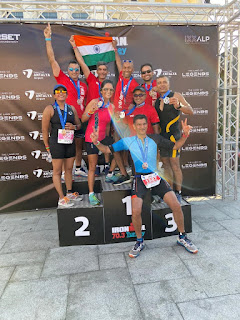Rishi was always there. And, with a smile.
My dear friend, Rishi Lalwani passed away on Sunday, 9th
July, 2023, at 9:30 am. I am still processing the shock and grief, over the
loss of a friend and a gentleman. Rishi was always there for everyone; he was
the classic 3 am friend, whether it was to party, or to go on a 4-hour cycle
ride, both of which have been done. He was an integral part of the SoBo running
and triathlon community, and it would be safe to say that Marine Drive won’t be
the same without him. In a group of alpha males (and females), Rishi was unique
– he trained as hard, if not harder than anyone around him, but somehow you
never felt that competitive edge, when cycling or running alongside him. And
before anyone pipes up – he was NOT overtraining. In fact, over the last year
or so, his training volume was the lowest I have ever known it to be.
Rishi was always there. And, with a smile.
In the middle of a long run, it was not unusual for Rishi to
suddenly up the tempo and leave us behind. We would wonder where he had
disappeared, and would find him a kilometre ahead, at Worli, or at Chowpatty.
He would be waiting for us with coconuts in his hands, all cut and ready to
consume, so we could hydrate mid-run, without losing time. And for all you
Garmin obsessed runners, you know what a big deal that is! Our good friend,
Roopali Mehta, an ace runner and nutritionist was his regular running partner,
who needs no introduction. Roopali stops for no one during her run, except for
nature, which she often needs to. Rishi would specially carry a five-rupee
coin, so she could use the Sulabh Sauchalyas along the way, and wait for her outside,
every time.
Rishi was always there. And, with a smile.
Let’s rewind to my favourite Rishi-Simran story. Flashback
to November, 2019, Antalya, Turkey, at the half Ironman triathlon. Rishi was
known as the Ironman in our group, because of having done several ‘full
Ironmans”. For the uninitiated, this consists of 3.8 km of sea swimming, 180 km
of cycling, and 42.2 km of running, and yes, it’s all to be done back to back,
with the idea being to spend as little time as possible in transition, between
disciplines. Rishi trained his dear wife, Simran to participate in the
triathlon, and here we were, all together in Turkey, for the event. He
chaperoned her through the swim, and gallantly waited outside the ladies change
area, for her to transition to the bike. A decent T1 (transition time), would
be around 5 minutes, but after 15 minutes when she did not show up, he started
getting worried, before madam finally appeared. It turned out that she spent
the extra time, applying sun-block and getting prettied up for the next leg, as
well as sharing cosmetics and skin-tips, with other triathletes! We must have
narrated that story a hundred times, and each time, I could sense a mix of
exasperation and joy in him, as we recalled that day. Their sweet daughter, Mallika
was our official photographer during the trip, and the only adult present,
might I add.
Rishi was always there. And, with a smile.
Rishi was a rare high-level athlete, who was always happy to run or cycle with those, much slower than him, and to give them company. If he saw you struggling mid-run, he would happily change his plan for the day, and give you the encouragement needed. His compassion extended off the field as well, till the very end. A week before his passing, when he was on a family holiday in Spain, they met an elderly couple in visible distress at Barcelona airport. It turned out, they had left their passport in the aircraft in their earlier flight, and were stranded. At the cost of missing his own connection, he accompanied them to various counters of the airport, to make sure they were safe and sorted.
I was fortunate to have run with him alone, about ten days
prior to that fateful Sunday. Usually, we have our entourage of Roopali,
Krishna and the good lord, aka Saroosh, with us. Our conversations are never
serious, but that day, serendipitously, we started talking about his life
story. I learned how his first job was selling greeting cards, made by NGOs
such, as CRY. He would buy bags of them from Mumbai and carry them to Pune,
several times a week, where he would sell them to corporate clients. By chance,
he landed up in the business of freight forwarding, in which he experienced
great success, through sheer dint of hard work, and practical acumen. His was
the classic story of landing up in Mumbai, with very little and making it big.
I felt privileged to have had the good fortune of hearing it all from him, in
great detail. When I met with Simran after the funeral, she narrated a string
of random events, over the past two weeks, which somehow seemed to be him
saying goodbye to the world.
As Simran told me, Rishi is in heaven and smiling at us. I
actually imagine him on a stationary bike, coconut water in hand, and when it’s
our turn, he will be there to welcome us. With a smile.
 |
| Rishi and Simran, Ironman, Turkey, Nov 2019 |
 |
 |
With Roopali and Simran at the 2023, Tata Mumbai Marathon |






.JPG)
.JPG)
